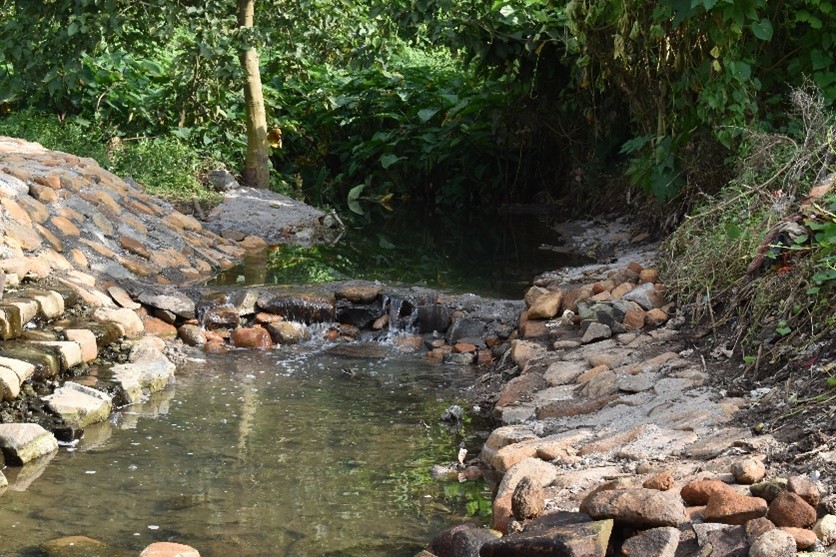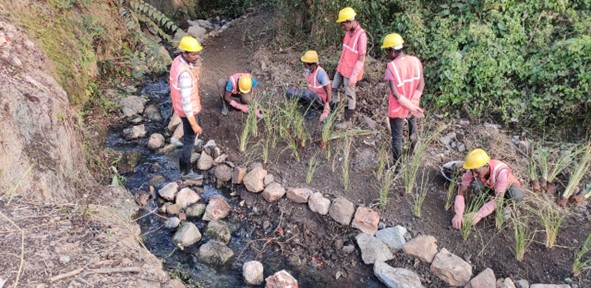
A stream which passes through 20 Acres of biodiversity park and meets the major river, Subarna Rekha, was restored using Ecological Restoration techniques by FORREST in 2021-22. The vision was to imitate natural processes to minimize the negative environmental impacts of grey water before it enters in Suvarnarekha River.
This project is in collaboration with Tata Steel Limited, Jamshedpur.
This restoration attempts to reverse ecological damage, bring back the natural ecological functional state of stream and enrich the stream biodiversity.
Restoration treatment methods adopted a combination of microbes, sunlight, and oxygen manipulation which is found in stable streams. The main advantage of natural treatment is that it is environmentally friendly and uses natural processes to purify water. Restoration used natural materials like rock, logs, and native plants to restore the stream.
Restoration of wetland is an effort for re-establishment of pre-disturbance aquatic functions and the related physical, chemical, and biological functions that wetlands perform.
Restoration of the stream employed four major techniques-
Through these restoration measures the abiotic conditions -dissolved oxygen, turbidity, light and temperature will be manipulated to clean the stream naturally. Through pools, riffles, ponds microhabitats were created which will influence aquatic species to survive and reproduce at that given location and time. This will increase and enrich the stream biodiversity.
Stream condition, before restoration


Restoration work:
Water Testing was carried out once at the beginning of the work and at the end of the restoration work to determine effect of restoration treatment.

Waste and weeds were removed from the restoration site.


Trash traps were installed at three water inlet points, These trash traps are designed to work efficiently in the stream conditions with heavy pollution. These are of GI steel and rust proof material

Riffles and pools construction
Riffle is an area of stream characterized by shallow depths with fast, turbulent water.
Riffles were created as segments of the stream where water flow is agitated by rocks. The rocky bottom provides protection from predators, food deposition and shelter. The turbulence and stream flow created by riffles results in high dissolved oxygen concentration.
Riffles created are at once a food source, a shelter from predators, and a conveyor belt that brings food to the stream animals. Many species of invertebrates reproduce or grow to maturity in riffles. Riffles provide habitat to midges, caddisflies, stoneflies and some mayflies which clings to stones and hide well in them.


Cross vanes and J hooks
Stones are placed in streams in the shape of a “C” or a “V” to direct water towards the center of the stream away from the stream bank and reduce erosion.
Rocks are placed in streams in the shape of a “J” , to channel the flow of water away from eroding stream banks. The “hook” or curved tip of the “J” has slots for fast-flowing water to pass through and creates small pools, where aquatic creatures can live.

Woody debris
Fallen trees, logs and stumps, roots, and piles of branches along the edges or across the streams are collectively called as woody debri.
Large tree logs, branches have been anchored along stream banks and across the stream as important feature as streams naturally rich in large woody debris tend to have erratic and complex channel morphologies. This works-


Cascades
Cascades help in dissolving more oxygen into stream water and it is also adds as an aesthetic element. 8 cascades were created in the stream.

Slope stabilization
Large stones are placed at the stream bank to prevent fast moving stormwater runoff from wearing away and destroying the stream bank. Native plants are planted beyond the rocks to hold the soil in place.


Creating water ponds
Water ponds are hotspots of biodiversity. These were created where water was naturally accumulating, and depressions were naturally present. Water lilies and lotus were added to the ponds.

Reintroduction of absent native riparian flora
Native trees and grasses were introduced in the ecosystem. Riparian vegetation play an important role in the stream corridor and offer many services to the stream ecosystem. Trees and their roots-


Biodiversity Documented on site-

connect@forrest-india.org
Copyright © 2022 forrest-ecology